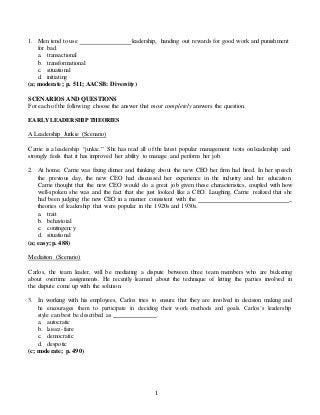
Ch.1d.docx
- 1. 1 1. Men tend to use leadership, handing out rewards for good work and punishment for bad. a. transactional b. transformational c. situational d. initiating (a; moderate; p. 511; AACSB: Diversity) SCENARIOS AND QUESTIONS For each of the following choose the answer that most completely answers the question. EARLY LEADERSHIP THEORIES A Leadership Junkie (Scenario) Carrie is a leadership “junkie.” She has read all of the latest popular management texts on leadership and strongly feels that it has improved her ability to manage and perform her job. 2. At home, Carrie was fixing dinner and thinking about the new CEO her firm had hired. In her speech the previous day, the new CEO had discussed her experience in the industry and her education. Carrie thought that the new CEO would do a great job given these characteristics, coupled with how well-spoken she was and the fact that she just looked like a CEO. Laughing, Carrie realized that she had been judging the new CEO in a manner consistent with the _ theories of leadership that were popular in the 1920s and 1930s. a. trait b. behavioral c. contingency d. situational (a; easy; p. 488) Mediation (Scenario) Carlos, the team leader, will be mediating a dispute between three team members who are bickering about overtime assignments. He recently learned about the technique of letting the parties involved in the dispute come up with the solution. 3. In working with his employees, Carlos tries to ensure that they are involved in decision making and he encourages them to participate in deciding their work methods and goals. Carlos’s leadership style can best be described as . a. autocratic b. laissez-faire c. democratic d. despotic (c; moderate; p. 490)
- 2. 2 CONTINGENCY THEORIESOF LEADERSHIP Jack and Jill (Scenario) Jack Jones and Jill Smith are both managers at a medium-sized medical supply firm. Jack emphasizes to his people that the work must be done, regardless of circumstances, and encourages his employees to meet their sales quotas. He is generally liked, but because sales are unstructured, sometimes his employees resent his rather heavy-handed approach. Jill has tried hard to build a good rapport with her employees and knows each of their families. She encourages her employees to work hard, but to be certain to take time for themselves and their families. 4. Fiedler’s contingency model would classify Jack as oriented. a. employee b. organization c. task d. relationship (c; easy; p. 494) 5. Fiedler’s contingency model would classify Jill as a. employee b. organization c. task d. relationship (d; easy; p. 494) oriented. 6. Which of the following would be assumed by Fiedler’s contingency model about the leadership styles of Jack and Jill? a. The leadership styles can be adjusted to fit the situation. b. The leadership styles are fixed, regardless of the situation. c. The leadership styles can be changed with appropriate training. d. Jack’s style is well suited for unstructured tasks. (b; moderate; p. 494) 7. Fiedler would expect that the best leadership style was a function of . a. leader-member relations, task structure, and position power b. formal authority, production process, and personality of employees c. chain of command, relationships, and power d. type of organization, personality of leader, and education of employees (a; moderate; p. 494)